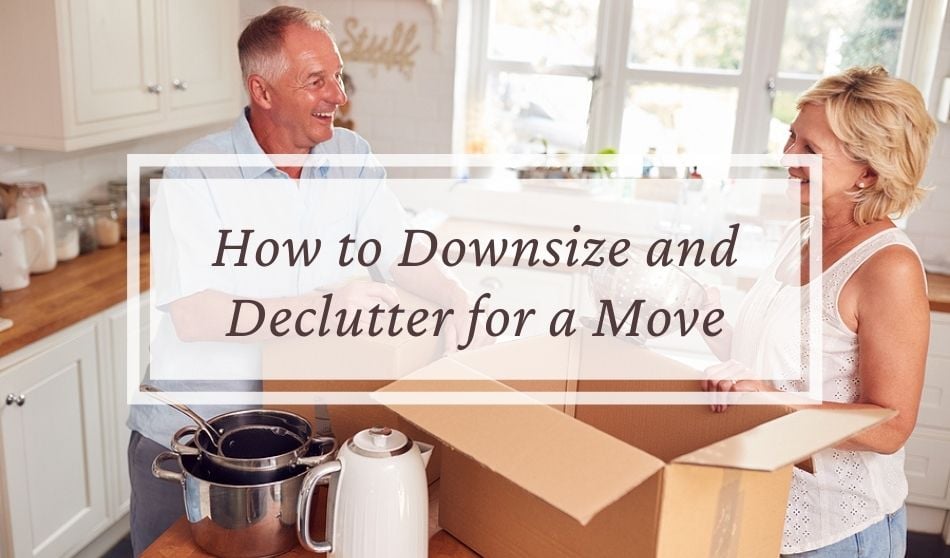
Moving is always stressful, but attempting to downsize and declutter before a move can add a whole new dimension to the pressures and tensions of the task.
Moving has consistently been sighted as one of the most stressful life events people experience.
Thankfully, pre-planning can save you a lot of strife. While moving is never completely stress-free, there are some ways you can ensure that the task is easier to handle. As you prepare to declutter and downsize, try these tips to make the process as smooth as possible.
When to Begin to Downsize and Declutter Before a Move
When you are in the heat of planning and prepping to move, you have a lot on your mind. Finding new housing, whether you plan to rent or buy, can be a stressful and expensive process. Between finding housing, movers, packing, and filling out all the necessary paperwork associated with moving, it can be tempting to forgo decluttering for the sake of speeding up the process. Unfortunately, when you are preparing for a move into a smaller home or apartment, you cannot skip this vital step.
Examine Your Timeline:
Your moving timeline is the single most important factor when it comes to deciding how your downsize and decluttering process will look. Predicting and anticipating your housing needs at least a few months out is the most ideal option. If you are approaching the end of your lease in a few months, it is a good idea to begin the downsizing process now. The sooner you can start reducing your belongings, the easier it will be on moving day. If your timeline is approaching quickly and a sudden move is on the horizon, you may need to temporarily rent a storage space until you can adequately declutter and downsize your belongings.
Start Decluttering as Soon as Possible:
Remember that downsizing is not always a simple process. Whether you decide to pass them along to family or simply to donate, sentimental items can be hard to part with. Sifting through even simple clutter can cause significant decision fatigue. It can be a taxing experience to attempt to cram the downsizing into a few weeks. Give yourself as much time as you possibly can. If you are a particularly sentimental person or are an older adult who may have family heirlooms in your possession, remember to allow additional time to seek a good home for those items. The same holds true for those who would like to have a yard sale before moving.
You will naturally need to schedule specific blocks of time to go through your things. This dedicated time will allow you to have the most impact. In the meantime, consider keeping a separate box in your home for donations. As you come across items in your day-to-day living that you don’t need, stick them in the box.
How to Downsize and Declutter Before a Move
While minimalist lifestyles are appealing for many, sorting through your belongings while knowing that you need to part with much of it can be overwhelming and even upsetting for some. Preventing those feelings entirely may not be possible, but you can ensure that the process is significantly more bearable with some key practices.
Start With the Easiest Items First:
When a big decluttering project is looming, it is tempting to immediately think of the hardest task and get overwhelmed. If you have enough lead-time before your move, your decluttering process will actually benefit from beginning with the easy items. Getting rid of that cumbersome clutter you know you don’t mind parting with can give you decluttering momentum as you approach the more emotionally difficult items.
Easy to declutter items include:
- Items you forgot you owned
- Ill-fitting clothes
- Expired items
- Broken items
Downsizing often comes with a lifestyle change, so donate the belongings that won’t be necessary in your new space (for example: gardening tools when you’re preparing to move to an apartment building). These belongings can immediately get tossed or donated respectively. Removing easy “no” items gives a clear picture of exactly what you have left. You may be surprised to find that you can easily keep that small box of family trinkets you were stressing over sorting through.
Assess The Essentials and Your Space “Budget”:
Just like with finances, space is finite and needs to be budgeted appropriately to ensure success. Fully assess what your budget will be when you move, a king-sized bed will take a lot of your square footage “budget” and may not work in a small space. Just like a financial budget you will have essential needs and wants that you can splurge on. Try to find a balance when evaluating your current belongings and deciding what to keep, declutter, or replace with a smaller version of the same item.
Creatively Evaluate your Sentimental Items:
Sentimental clutter can be the hardest to part with during a downsize. If you don’t have the space to keep all the belongings that feel important, try to think creatively about them. Sentimental papers, photographs and ticket stubs can be easily displayed in a shadow box on the wall, or in a photo album. This can eliminate the need to use up storage space in your closet for a shoebox of personal items. If you own decor or other sentimental items that you will not have space to keep, take photos of them with a note explaining their importance. Creating a museum-like album of your life artifacts acts as a portable way to preserve your memories without the need to keep all the stuff itself. This is an excellent trick for old baby clothes, toys, and knick-knacks that you wouldn’t want to display, but ideally would keep in a larger space.
Beginning to downsize and declutter can be an overwhelming process if you don’t approach it with a good plan. Avoid a lot of the extra stress that comes with moving by keeping these downsizing tricks up your sleeve.





